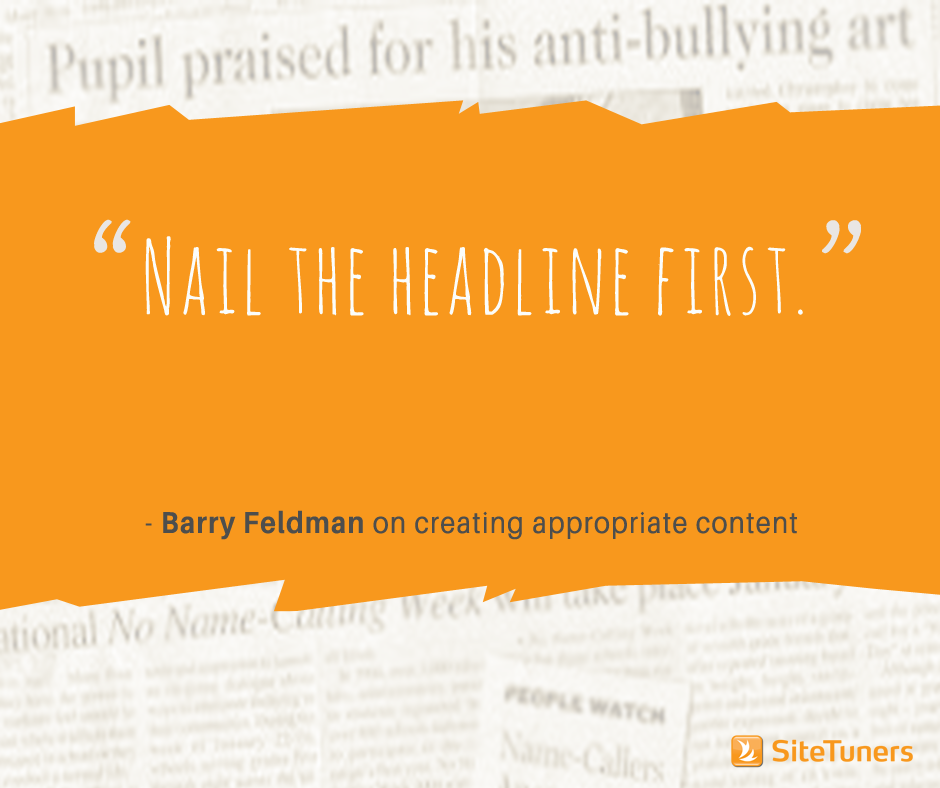
That’s what Barry Feldman, Content Marketing Consultant and owner of Feldman Creative likes to remind writers across different industries.
In an episode of Landing Page Optimization, Barry lays down the essentials to producing content that speaks to the audience– from using visuals to considering the buyer journey.
Get into the user’s mindset
Companies who create good content talk about their readers, not their brand or product.
Barry shares that if you talk about your company too much, you fail the French test because your site is probably overpopulated by the word ‘we.’
Keep in mind that customers are on your site not because they care about you. They’re there because they have problems to address. So be relatable by tapping into their wants and needs.
Ann Handley, author of Everybody Writes, emphasizes the importance of developing pathological empathy for your customers.
Walk a mile in your audience’s shoes and, through your content, communicate that you understand where they’re coming from.
Here are a couple of things you can do to get to know your audience:
1. Talk to your customers. Ask …
- how their relationship with you came to be
- how they discovered you
- how you helped them in the past
- how you can help them in the future
It’s critical to identify who your ideal customer is, so you can get more people like them.
2. Watch customers in the wild.
Aside from observing on the leading social networks, you can also learn how people behave, how they talk, and what their motivations and questions are by reading …
- reviews
- forums
- blog comment sections
Highlight the benefits
When you understand your reader intimately and you start writing content, nail the headline first .
Start by filling in this blank with a benefit to the reader.
That won’t necessarily give you the perfect headline, but it will guide your messaging.
If you begin with the benefit, you identify what you’re going to create content about, and the reader will know what they’re going to get out of the content.
Again, readers don’t care about your brand or company. They will only stick around if they immediately know what’s in it for them. Talk about how you can address their pain points, and get to that part fast.
Balance with visuals
As with any form of communication, online content requires a fine balance between verbal and visual messaging.
Generally, if a visitor lands on a web page or a site with a lot of pages that are walls of text, they’ll get bored. They won’t have a great user experience, and your content will not be consumed.
Consider varying attention spans
Different forms of content will be consumed in different contexts.
Instant-access content
There’s going to be a lot of noise for instant-access content like, say, a social media post or blog article. Chances are, your audience is busy or multitasking.
Barry notes that they could be going about their morning routine and attracted to your page while checking their inbox. You’re dealing with attention challenge and media overload, so you’ll need more focus.
Downloadable assets
On the other hand, if it’s a downloadable asset that people have to give up their e-mail address for, the reader probably has higher interest or desire – they’re more invested.
In this scenario, you can worry less about the attention span and try out longer formats and insert a variety of multimedia.
It goes without saying though that you have to consider the timing, niche, and media you’re using. Experiment with different formats to find out what resonates with your audience.
Keep the customer journey in mind
The role of a marketer has become closer to that of a salesperson.
With high-ticket, complicated purchases (e.g. business-to-business purchase), for instance, customers tend not to reach out to a salesperson until very late in process.
So as content marketer, think about all the stages in the sales funnel – one that moves from awareness, evaluation, to decision. You’ll then need to apply creative principles to appeal to different customers at different stages in the journey.
1. At the top of the funnel, you’ll need to capture their attention and make emotional connection. Know what touches them emotionally, and tell a story.
2. Further down the funnel, you’ll have to build a relationship, then answer questions about your product or service like:
- What does it cost?
- How does it compare?
- What are the terms?
Putting It All Together
The starting point to producing content that resonates with your audience is making sure that it’s aligned with their goals and motivations. If you want your content consumed, talk about your customers and their pain points, not your brand or product.
Once you have that down, create content that highlights the benefits for the reader and uses visuals to maintain attention.
Keep in mind that customers are at different stages of the funnel. How they engage with a specific type of content depends on where they are in the customer journey.


